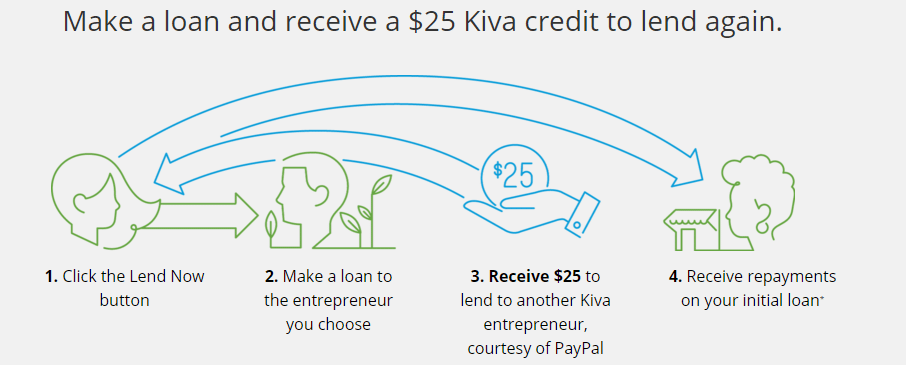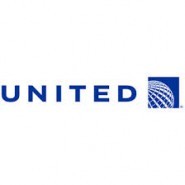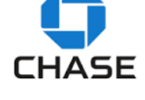Deal has expired, view more PayPal deals by clicking here.
Update 5/7/19: Deal is back for 2019. Hat tip to MtM
The Offer
- Loan someone $25 or more through the KIVA loan system with Paypal payment and Paypal will give you another $25 to loan out. Keep in mind repayments made on your loan made with the promotional Kiva credit will be returned to the Kiva PayPal Donor Advised Fund to be used in future lending campaigns.
The Fine Print
- “Qualification Period”: Starts at 12:01:00 a.m. Pacific Time (“PT”) on May 1, 2019 and ends the earlier of (2) 11:59:59 p.m. PT on May 11, 2019 or when the total Reward amount reaches five thousand (5,000) loans.
- “Redemption Period”: Starts at 12:01:00 a.m. Pacific Time on May 1, 2019 and ends at 11:59:59 p.m. PT June 15, 2019.
- “Reward”: A Kiva credit in the amount of USD $25.00 to make another loan using the Kiva.org platform during the Redemption Period to a qualified borrower registered with Kiva on Kiva’s platform and located outside the United States. Proceeds from the loan are not payable to Eligible Participants and are instead payable to the Kiva PayPal Donor Advised Fund. Rewards are not tax deductible. There is a limit of one (1) Reward per Eligible Participant.
Our Verdict
Some people like to manufacture credit card spend with Kiva. I have some issues with micro lending in general, but if you’re a fan of the program then this is effectively a way to double your “donation” via Kiva & PayPal.
Hat tip to reader Sergio R







so basically PayPal will match my funding. This doesn’t appear to be that tempting. Please let me know if I am misunderstanding this.
I need to see Kiva during a financial crisis before I’m going that route for MS. 3% CC return on loans with a 98% repayment rate isn’t great unless I can do 1 month loans. Even then unless I can lend $1k+ what’s the point? I make $30 and deal with the hassle and risk?
Also consider war and natural disasters. I’ve lost a loan due to death. I’ve seen a field partner shut due to war, a few times it’s delayed payments. I’ll likely lose a lot if the Philippians gets some major weather thing.
If you’re ready for those events than use KivaLens and apply filters. I’ve made over almost 1500 loans over 5 years and lost 0.9% (less than 1%). It took almost 2 years before I started looking at default rates and currency loss, so I imagine in the last 3 years the numbers are even better.
And there’s a couple 5% for charity cards out there.
This article about Kiva was posted today – https://www.pointchaser.com/not-using-kiva-earn-points-miles/
4 Stars from charity navigator and public postings of all their financials but maybe I should listen to the person contributing to a frequent flyer blog about manufactured spending instead. Longtime supporter of Kiva and I’ll happily let Paypal contribute another $25.
The star rating from charity navigator doesn’t really matter in this case. The issue that a lot of people have with Kiva is that the loan agents on the ground often charge extremely high APRs.
Surprising amount of knowledge about the appropriate APR for a loan in, say, Rwanda. Alright internet, what do you think Urwego Bank *should* be charging for interest for their loans. As you know, the Rwandan Franc has been under pressure lately, inflation is low, and the Monetary Policy Committee just cut their lending rate a half basis point to 5%.
You realize that some of the lenders charge absurd rates that are more akin to payday lenders than a traditional bank? In addition the Kiva lender is taking on the default risk aren’t they as not all loans are paid back?
I realize that I am not an expert in what are and what are not absurd practices for people in developing countries, where I am also not an expert in their banking systems and access to loans. I suspect the lenders based in these countries, who this accredited charity deals with, know more than I do. The fact that he default rate is fairly low and there is constant demand for more loans indicates to me the rates are not “too high”, or are not considered too high by the borrowers.
And yes, my Kiva loan default rate is over 5%. But normally when you give to a charity, which I and most of the world consider Kiva to be, you don’t get any money back. I’m glad to get the 95% back to lend out again.
It’s fine to disagree. If people don’t find Kiva trustworthy or consider their practices predatory they certainly don’t have to use them. Personally I think poking holes in their credibility and potentially decreasing the future amount of microloans available to disadvantaged people would be a shame.
I’d encourage you to look at alternatives to Kiva and understand the reasons people take issue with Kiva itself. For example Zidisha does the same thing but without using MFIs. Your post makes it seem like people will either give to Kiva or do nothing, when that simply isn’t and shouldn’t be the case.
Zidisha has only managed to disburse only 15 million dollars while kiva has lent 1.3 billion dollars. Its not a viable alternative, one could close their entire loan portfolio with $2000 in loans. Guess the MFI’s serve some purpose after all.
I gave you one alternative. If you want to keep “donating” with Kiva that’s your choice, my point was simply that looking at their charity navigator star rating means nothing.
I’d encourage you to click through to the sources I cited and learn more about this. The default rates are higher than what Kiva reports. The reason the repayment rate remains so high is because some of these banks will cover the defaulting loans out of pocket in order to maintain their good standing with Kiva. In other words, it’s not always the Nigerian farmer paying you back. It’s the bank that took what you thought was an interest-free loan and dispersed it at 36-100% interest. There is nothing fair or transparent about that, which is the whole point of the article. I’d rather issue an interest-free “loan” that doesn’t get paid back but helps someone, than make an interest-free loan to a bank that takes advantage of people in this way.
I’m not an economist, nor do I pretend to be one on TV. I have been aware of several of these concerns people have raised with Kiva, and I think the complexity of trying to do finance in all of these countries different is part of why Kiva glosses over some of these. Having not training in these sorts of economics and finance topics, rather than try to analyze these things and figure out what impacts they have on the final process, I think there are several things in play here that I’ll try to list more than analyze. Operating costs. I assume these are lower due to cost of living, but I have no idea how lending works in these countries. How rigorous is the underwriting? Are there no loan origination fees that cover the fixed costs that cannot be covered by a low interest rate on a microloan? Prevailing local interest rates. Lending is risky business, and some of these borrowers do not seem to have stable repayment sources. This probably leads to higher overall interest rates. As people have pointed out, the financer (kiva lenders) are taking some of the risk, but also as people have pointed out, so are the lenders (as they sometimes cover defaults). Both Kiva and the lenders have a shared interest in being able to return most of the principal to US lenders. If 50% of the loans were actually defaulting it’d be really hard to raise capital. For what it’s worth, I’ve had 1 loan officially default, and I think 1 loan show the entrepreneur being behind, but eventually the field partner paid. I don’t have a huge portfolio, only having done ~30 loans, but even if we double the default losses, I don’t think the “true” rate is going to be that much higher than what they’re reporting. Lending pool, we are basically contributing capital to the banks at low cost. Bail out? That might be one term if the bank is undercapitalized. If not, then aren’t they just fundraising? What role do the different central banks play in their countries? Are they making low interest loans to banks like the US federal reserve does with the Federal Funds rate? Is there healthy competition in these countries that helps keep borrower costs down? Yes, we’re not selecting exactly who receives money, we are but one source of their lending capital. Who finances payday loan companies anyways? If they’re making money hand over fist, why don’t the big banks get into it? Are borrowers people better off with or without loans? Assuming a non-infinite supply of capital, how many of these people would not get the loan that they do? Just like a business here choosing to run off of a line of credit, or a person getting a mortgage, who is to say what is excessive or not worth it? At what interest rate is a payday loan excessive and exploitative? What would people who make use of payday loans… Read more »
I’ve spent time in Botswana. What William Charles said is on point.
I mean it seems like you agree on the facts with the FF blog just not on whether or not that’s a bad thing. Sure that might be the “right” APR for those loan but that doesn’t mean telling me it’s “interest free financing” is entirely true — any not telling the truth is objectively bad.
Interesting counterpoint: https://frequentmiler.boardingarea.com/why-i-love-kiva-for-earning-rewards-and-doing-good/#comments
Interesting how everyone is ragging on Kiva, yet there is no cost to the borrower. No interest, no fee to apply, etc. I personally know of two people who have been fully funded and know this to be the truth. Do some research.
I’ve done research before and most Kiva loans aren’t interest free.
They do mark whether the borrowers are paying interest.
It’s a pretty dumb promotion. I just get to choose how they make a $25 high interest loan. I’ll pass on that one.
What Matt says. Day in the life of a loan officer with a vendetta for goodness I guess is the promo.
I do kiva for fun sometimes, so I’ll take an extra loan. I’ll use the “house” money to make a higher risk loan.
Would you care to elaborate what issues you have with micro lending? I’m genuinely interested
I can’t speak for OP but two criticisms are: you’re not always supporting the person getting the loan, you’re providing risk free capital to a for-profit “bank” for whatever they want. Or that the money is being lent at high interest because that’s what the economics dictate or the field partners are crooks.
US delinquency and charge off rates for loans are ~2% despite stable economics and robust underwriting. There are a dozen+ field partners on Kiva in 3rd/4th world countries that haven’t had a single loan fail in years. They haven’t lost a single cent in currency fluctuations.
This sounds great to me.
The field partners on kiva are very well vetted, and many are non-profits themselves — so crooks or structural profit takers are rare. The reason that they don’t expose kiva lenders to borrower or currency loss is because they cover those out of their operating surpluses from performing loans, ultimately keeping a higher flow of funds than if they did expose losses.
Lending in general is a transfer of wealth from the poor to the wealthy, especially the bigger the institutions get. Just think about this…the Federal Reserve charges A) The US government interest AND B) pass on interest rates to banks who also pay the Federal Reserve (when necessary by borrowing) money to give out loans to consumers. The owners of the Federal Reserve make millions upon millions each year. Bank shareholders aren’t a whole lot different and Executives make quite a bit from all of this. It’s just that consumers are so focused on the Joneses that they can’t pass on not having a new car and a big house so they pay 15% of their paycheck to a bank every month. The average person will have written $500,000 to a bank at the end of their life. Meanwhile, intelligent people have the bank write them a check for $200,000 over the course of their life and invest the extra $500K they would’ve given to the bank to have shiny toys they can’t afford. Kiva, it appears not only charges these people with great track records interest, but extremely high levels of interest, akin to immoral fraud.
“The owners of the Federal Reserve” lol… did not realize this site attracts crackpots too.
thanks for the heads up. remember 3x on FlexPerks.
nvm, i recall now that venture is dead.
I funded a 5month loan. The reward was available for immediate use (a page pops up, no check email or anything) – so paypal generously funded an 8year loan for a low income student to go to college.
Win, win, win.